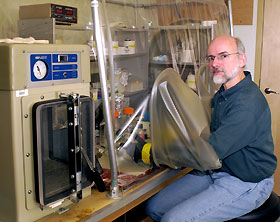For more archives, go to the Advance Archive/Search Page.
Heat-Loving Bacterium May Shed
Light On Evolution Of Early Life
 |
|
Kenneth Noll, an associate professor of molecular and cell biology, works in an anaerobic chamber used to create artificial environments, to research bacteria that live in low-oxygen, high-temperature habitats. |
|
Photo by Jordan Bender
|
Kenneth Noll, an associate professor of molecular and cell biology, has always been intrigued by evolution and unusual life forms. As a child, when his science class was assigned to write about a reptile, he turned in a report about the Komodo dragon.
So it’s no surprise that his research centers on an unusual heat-loving bacterium, Thermotoga maritima, and its role in the evolution of very early life.
Thermotoga is an extremophile – an organism that grows in extreme conditions. It’s found in nature in the sediment surrounding deep sea “smokers,” extremely hot water that shoots up from the ocean floor, forming mineral columns in places where the earth’s plates meet. It was discovered in sediment near a volcano at Vulcano, Italy, in 1986. It can grow at temperatures of 90 degrees Celsius, which Noll likens to the temperature of a well-done steak.
Thermotoga’s hottest claim to fame, however, is that a quarter of its genes seem to have been inherited not from other bacteria but from a completely different life form, the Archaea. This discovery, in 1999, has refueled scientific inquiry into whether evolution should be described not as a tree of life branching out from an original seed, but as a complex thicket of relationships.
It was only in 1977 that the existence of Archaea was discovered, by a microbiology professor at the University of Illinois, Carl Woese, who was Noll’s postdoctoral mentor. Woese differentiated the Archaea from the bacteria, although neither life form has a nucleus, unlike the more complex eukaryotes, such as plants, animals and fungi.
The similar structures of some bacteria and Archaea renewed interest in the idea of horizontal gene transfer – the transfer of genetic code among organisms. The more common and familiar transfer of genes is “vertical” – a gradual process, from parent to progeny, all the way back to a common ancestor, as Darwin proposed.
If organisms share genes or get them from other species, it creates a much more complex network of relationships, making it difficult, if not impossible, to find a common ancestor. If some organisms can transfer their genetic material that easily, Noll says, it may be that the rules of evolution are different for them.
Thermotoga maritima, with its one-quarter share of Archaea genes, is “the poster child of horizontal gene transfer,” Noll says. It has more genes from Archaea than any other bacteria, and it lives in environments with lots of Archaea around.
Scientists don’t know how horizontal gene transfer takes place in nature, although they can foster it in the laboratory. Noll has descended into the deep ocean in Alvin, the Navy’s deep-sea submersible, to collect Thermotoga, but he currently gets his supply from culture depositories.
The bacteria can tolerate room temperature, which must seem like an icebox to them, Noll says, but they thrive and grow colonies in an oven, where most bacterial cultures would die.
Noll is particularly interested in Thermotoga’s transporter genes and the sugars that they carry, and he collaborates with J. Peter Gogarten, a professor of molecular and cell biology, on a joint NASA grant. If he can find which sugars go with which particular transporters, he may then study Archaea to see if their sugar transporters function the same way, Noll says.
The proteins that are involved in the sugar transport process in Thermotoga have a DNA code that looks like genes that come from Archaea, he notes.
One of the questions about horizontal gene transfer is how a gene from one form of life functions in another form, he says: “It’s like taking a Volkswagen carburetor and trying to make it work in a Mercedes. How do the genes change in order to function in the new organism? How do they get organized in the new environment?”
Many Archaea grow at very high temperatures, like Thermotoga. One theory is that the first life existed at very hot temperatures, Noll says. Another idea, derived from recent NASA studies, is that after life developed, “planet buster” comets hit the earth, heating things up and destroying most organisms. The life that sprang back evolved from heat-loving microbes that could survive in that environment, possibly Archaea and Thermotoga.
One question being argued in the scientific community is whether horizontal gene transfer was rampant in that early stew of life, or whether it’s a rare event. Did most of it happen billions of years ago, or more recently?
“We don’t have a sense of the time scale,” Noll says.
It could be that the transfer happened a long time ago, or that once one organism gets a set of genes from another life form, all pick it up.
“We don’t think they transfer that easily,” he says.
There have been some proven reports of horizontal gene transfer in higher organisms – in fruit flies, for instance, Noll says, adding that although a report a few years ago of bacterial genes in the human genome made a big splash, it was later shown to be mistaken.
The questions about horizontal gene transfer and its implications for evolution are attracting a lot of interest, Noll says. “There’s just a lot out there we don’t know.”
